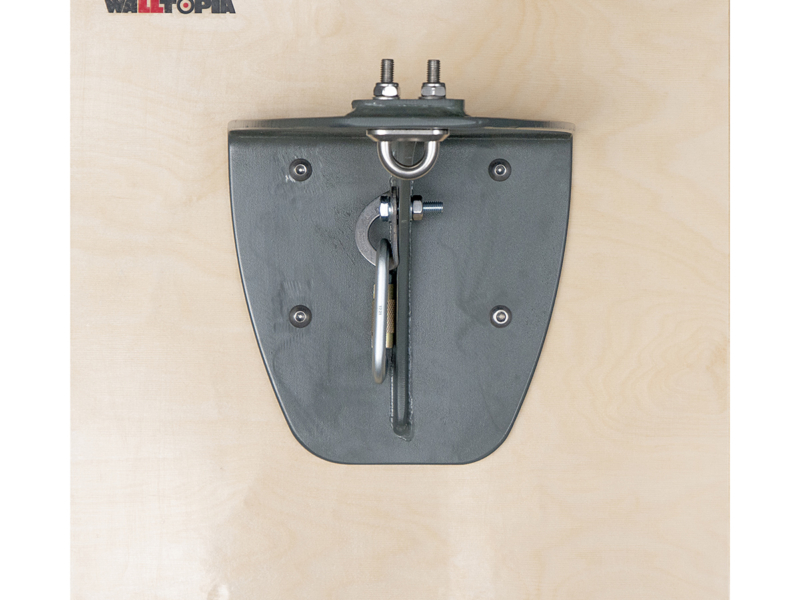T-nuts
The only requirement the standards include regarding the t-nuts is about their breaking point (according to Annex E). We believe this is not enough. Our t-nut holds are sturdily, and are also strongly fixed to the wall panel with two solid screws, preventing it from getting out of the panel even if the hold installation fails.
T-nuts distribution
We make sure that there are always enough t-nuts around the corners so that the wall makes no compromise with the route-setting opportunities. Competitor producers connect the plywood panels via wooden pieces and it makes it not possible to place T-nuts around the corners. We have a solution to this and we can place t-nuts close to the edges and corners.
Individual Protection Points
Walltopia U-bolt
Rope climbing walls feature a vital piece of equipment – individual protection points for every lead climbing line. They are connected with the main support structure of the climbing wall. Keeping in mind the load cycles and wear that each point bears in a commercial climbing gym plus the constant vibrations to which a wall is exposed and sometimes even the lock-nut gets unscrewed, resulting in a severe threat to the climber’s well-being, we have invented the U-bolt which is now part of our standard equipment:
✓ It keeps the quick link from wearing out
✓ It is equally strong on both vertical walls and roofs with break value of 35 kN
✓ It’s fixed to the metal construction with not just one but 4 nuts, 3 of which can loosen and the protection point will remain safe.
Protection Points Attachment
Every Corner Matters
We go beyond the requirements of the international standards to ensure that all protection points are precisely calculated by creating a complete 3D model with all climbing wall elements. Then we apply the normative loads on each one of the protection points successively and in the process we find the most unfavorable protection point for each element and each connection between the elements. This way we can calculate the structural integrity of the wall, taking into account every corner of the wall.
Top Anchor
Walltopia top anchor is a device that is mounted on top of the climbing route, and is suitable for both top rope and lead climbing. It keeps the carabiners at a distance from the wall panels, therefore removing the risk of friction between the rope and the wall’s texture. This allows the device to be mounted on huge overhangs and roofs along with slabs up to 10 degrees.
Benefits
- Keeps the carabiners and rope at a distance from the climbing wall
- No friction between rope and the wall’s texture
- Suitable for big overhangs and roofs
- Carabiners and maillons are replaceable – you can easily put any carabiner on the device
- Good for both lead and top rope climbing
- Suitable for slabs up to 10 degrees
- Made of stainless steel (indoor and outdoor use)
Belay bar
The Walltopia belay bar is a device that is mounted on top of the climbing route. It offers a belay station for both top rope and lead climbing, as there are two separate placements for the top rope and the lead rope – a smooth cylinder for the top rope and the regular two facing-locks carabiners for lead climbing.
Benefits
- Doubles the life of the ropes
- Reduces the effort in the process of belaying
Features
- Has two carabiners to serve as a top station for lead climbing
- Stainless steel (indoor and outdoor use)
Auto Belay Top Plate
The Walltopia Auto Belay Top Plate is an anchor that is mounted on top of a climbing lane, designed specifically for auto belays. The plate keeps the auto belay at the correct distance from the climbing wall, so that the device does not bounce against the panels and the belay webbing can run freely.
Benefits
- Specially designed for auto belays
- Dual redundancy according to standards and requirements of auto belay manufacturers
- Possible to use outdoors










